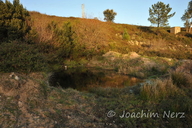|
Description
Lissotriton boscai males have a total length up to 75 mm, and females are up to 94 mm total length. Tail length approximately
equal to snout-vent length. Superficially similar to L. vulgaris or
L. helveticus. Paratoids indistinct. Glandular ridges alongside the
back give the newt a square-backed appearance. The skin is dry and granular
during the terrestrial phase. Breeding dress is much less elaborate than in
other Lissotriton species. Breeding animals lack a dorsal crest, but
have a low, smooth crest along the tail, which is slightly higher in males.
Lacks a stripe across the eye. Males also develop a larger protuberance at
the tail tip (0.5-2mm) than females (0.5mm).
The brownish, yellow or olive back is covered with a dark spotting pattern,
which may be coarser in males. The orange-yellow venter is separated from
the dark dorsal side by two bright whitish lateral stripes. The spotting
pattern of the back can continue across the lateral bands onto the venter.
Males possess a bright spot at the tail-tip.
Distribution and Habitat
Country distribution from AmphibiaWeb's database: Portugal, Spain
Lissotriton boscai is endemic to the Iberian Peninsula. It is absent from the
eastern and north-eastern parts of the peninsula. In Spain, it is distributed
throughout the following regions: Galicia, Asturias, León Zamora, Salamanca
and as far as Guadarrama and Toledo Mountains.
Lissotriton boscai is also documented in Estremadura, Toledo, Ciudad Real and
western Andalucia. Its easternmost limit is the region of Córdoba. In Portugal,
Lissotriton boscai is found from the north to the south. In the south it is not
as common and has been found in mountain areas. In the north it is sympatric
with Triturus marmoratus, L. helveticus, Chioglossa lusitanica and
Salamandra salamandra.
Lissotriton boscai is more aquatic in its habits than T. marmoratus and
L. helveticus. It can be found on peat moss, in running water or in
deep still waters. However, it prefers small shallow ponds with vegetation.
During the terrestrial stage, the animals can be found near ponds, hiding in
humid and shady places, such as under roots, stones, moss and trees.
It occurs from sea level up to 1500 m a.s.l. in Portugal, Serra do Gerês,
Serra da Estrela, and to about 1800 m in Galicia, Spain (Gasc 1997).
Noellert and Noellert (1992), however, report that the species occurs
up to 1940 m in the Serra da Estrela.
Life History, Abundance, Activity, and Special Behaviors
The reproductive period extends from the end of November until July. The
courtship takes place in water. The male positions himself in front of
the female and fans water towards the female. This fanning behaviour is
thought to transmit male odors to the female. This behaviour can be repeatedly
interrupted by a wiggeling of the tail tip or a stance in which the male
presents its cloaca by turning it toward the female and raising his tail
vertically, then slowly moving it from side to side. The fanning gets faster
and more powerfull, ans the male occasionally hitts the female's head with
his tail. The male then slowly walks away from the female, continuing the
fanning movements with his tail. The female follows and induces the male to
deposit a spermatophore by touching his tail with her head. The pair then
walks a bit forther until the male blocks the female's path and pushes her
back over the spermatophore with his tail. A single female can produce 100-240
eggs each season. The eggs are about 2 mm across and the gelatinous envelope
is somewhat oval. They are laid individually on water plants. Larvae were
observed in the province of Sevilla from the end of March until June. Larvae at
higher elevations may spend the winter in the water and metamorphose the next
spring/summer. Larvae are up to 45 mm total length before metamorphosis, and
about 30-35 mm after metamorphosis. Although they sometimes spend the entire
year in the water, adults usually leave the water at the end of May and spend
the summer on land. They may be active during day and night during the
breeding season, then switching to nocturnal activity during the terrestrial
phase. The diet consists of invertebrates of up to 9.7 mm for adults. The
larvae usually eat Daphnia, and Diptera larvae
(Noellert and Noellert 1992).
Trends and Threats
Lissotriton boscai is threatened in some breedings waters in Spain. Its exact
status in these areas is unknown (Noellert and Noellert 1992). It is,
however, protected by law in Spain. In Portugal, it is more or less common
and considered not endangered (Gasc 1997).
Possible reasons for amphibian decline General habitat alteration and loss
References
Gasc, J.-P. (1997). Atlas of Amphibians and Reptiles in Europe. Societas Europaea Herpetologica, Bonn, Germany.
Griffiths, R.A. (1996). Newts and Salamanders of Europe. T. and A. D. Poyser, London.
Nöllert, A. and Nöllert, C. (1992). Die Amphibien Europas. Franckh-Kosmos Verlags-GmbH and Company, Stuttgart.
Stumpel-Rieks, S. E. (1992). Nomina Herpetofaunae Europaeae. AULA-Verlag, Wiesbaden.
Originally submitted by: Arie van der Meijden (first posted 2000-01-14)
Edited by: Sean Schoville (1/18/00) (2022-11-03)Species Account Citation: AmphibiaWeb 2022 Lissotriton boscai: Bosca's newt <https://amphibiaweb.org/species/4293> University of California, Berkeley, CA, USA. Accessed Jun 6, 2025.
Feedback or comments about this page.
Citation: AmphibiaWeb. 2025. <https://amphibiaweb.org> University of California, Berkeley, CA, USA. Accessed 6 Jun 2025.
AmphibiaWeb's policy on data use.
|




 Raffaëlli Account
Raffaëlli Account Map of Life
Map of Life